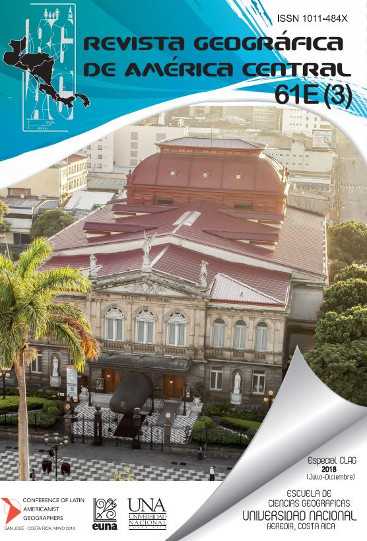Mapping Miskitu subsistence land use change in Concejo Territorial Katainasta, Honduras
DOI:
https://doi.org/10.15359/rgac.61-3.33Keywords:
Honduras, Miskitu, concejo territorial, indigenous, resource useAbstract
Understanding the large-scale spatial patterns of natural resource use in indigenous homelands is critical for guaranteeing indigenous peoples’ ancestral land rights, designing effective conservation policies, and promoting good governance in Central America. However, few studies have mapped the diachronic distribution of indigenous communities’ resource use in these areas. Here we present a case study describing the spatial functionality of the Concejo Territorial Katainasta (CTK)--the first indigenous territorial jurisdiction in Honduras to receive an intercommunity land title. Two participatory research mapping (PRM) studies--the first in 1992 and the second in 2014-15--mapped the spatial patterns of Miskitu subsistence activities in CTK. The results were subsequently converted into a geographic information system (GIS) that allowed for spatial and temporal comparisons of Miskitu subsistence livelihoods in CTK before and after the titling process. Here we focus on the spatial parameters of three Miskitu subsistence livelihoods: agriculture, hunting and fishing. Analysis of results suggests that 1) the 2014-15 subsistence use areas for Miskitu communities in CTK have not diverged dramatically from those of the 1992 study, and 2) the new legal boundaries of CTK adequately encompass the subsistence use areas of its constituent communities and recognize the historical overlaps in Miskitu resource use and tenure patterns.
References
Álvarez, R., Pantoja, E., Granados, G. & Paz, A. (2017). “Strengthening Indigenous Peoples Land Rights in Honduras: The Miskitu People's Experience of Collective Land Titling, Lessons Learned, and Main Challenges for the Future.” Paper presented at the 2017 World Bank Conference on Land and Poverty, Washington, D.C.
Cochran, D. M. (2008). Who Will Work the Land? National Integration, Cash Economies, and the Future of Shifting Cultivation in the Honduran Mosquitia. Journal of Latin American Geography, 7(1), 57-84.
Dunn, M. A. & Smith, D. A. (2011). The Spatial Patterns of Miskitu Hunting in Northeastern Honduras: Lessons for Wildlife Management in Tropical Forests. Journal of Latin American Geography, 10(1), 85-108.
Galeana, F. & Pantoja, E. (2013). Strengthening Indigenous Peoples' Land Tenure Governance: The Case of the Miskito People in Honduras. Paper presented at the Annual World Bank Conference on Land and Poverty, Washington, D.C.
Herlihy, P. H. (2001). Indigenous and Ladino Peoples of the Río Plátano Biosphere Reserve, Honduras. In S. C. Stonich (Ed.), Endangered Peoples of Latin America: Struggles to Survive and Thrive (pp. 100-120). Westport, CT: Greenwood Press.
Herlihy, P. H. & Knapp, G. (2003). Maps of, by, and for the Peoples of Latin America. Human Organization, 62(4), 303-314.
Herlihy, P. H. & Leake, A. P. (1997). Participatory Research Mapping of Indigenous Lands in the Honduran Mosquitia. In A. R. Pebley & L. Rosero-Bixby (Eds.), Demographic Diversity and Change in the Central American Isthmus (pp. 707-736). Santa Monica, CA: Rand Books.
Herlihy, P. H., Tappan, T. A. & Fahrenbruch, M. L. (2018). Recognizing Indigenous Territories in Central America. Paper presented at the 35th Conference of Latin Americanist Geographers, San José, Costa Rica.
INA. (2012). Título Definitivo de Propiedad Intercomunitario en Domino Pleno (Concejo Territorial KATAINASTA). In Registration No.2621.
Published
How to Cite
Issue
Section
License
Proposed policy for journals offering Open Access
Authors publishing their works in the Journal acknowledge and agree to the following terms:
a) Authors retain the copyrights to their works and guarantee the Journal the right to be the first to publish their works, under the Creative Commons License Attribution-NonCommercial-ShareAlike 4.0 International, CC BY-NC-SA 4.0 International (https://creativecommons.org/licenses/by-nc-sa/4.0/deed.es), which allows others to share works upon complying with the acknowledgment of authorship and mention of the Journal as the original publisher of the work.
b) Authors are permitted to separately establish additional agreements for the non-exclusive distribution of the official edition of the work published in the Journal (for example, authors may desire to place the work in an institutional repository or incorporate it into a book that is to published elsewhere) so long they acknowledgment to recognize the Journal as the original publisher. The aforementioned additional agreements must respect the terms of the non-profit character and sharing philosophy of the original license (CC BY-NC-SA 4.0 International, https://creativecommons.org/licenses/by-nc-sa/4.0/deed.es).
c) Authors are encouraged to archive the post-print or editor/PDF version in Open Access repositories.






 REVGEO is licensed under https://creativecommons.org/licenses/by-nc-sa/4.0/deed.es
REVGEO is licensed under https://creativecommons.org/licenses/by-nc-sa/4.0/deed.es
.svg_4.png)

_(1).png)
_(1)_(1)_(1)_1.png)
(2)(1)(1)(1).png)
